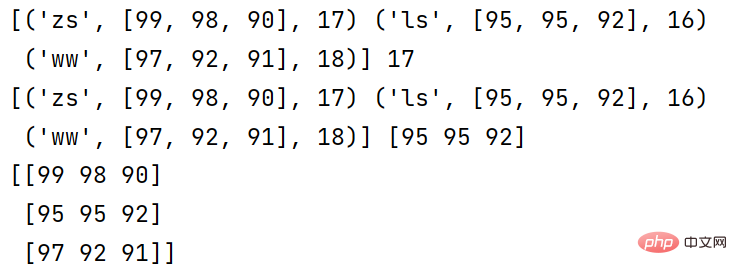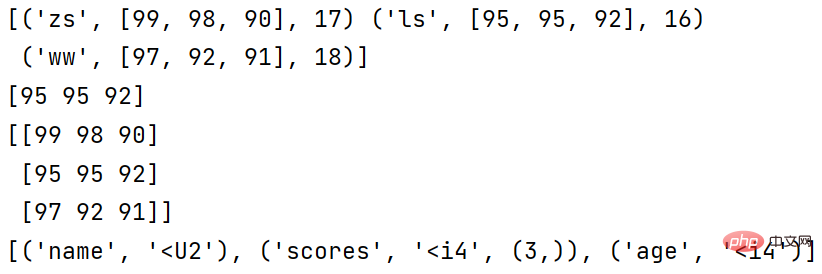Python数据类型简介之numpy
本篇文章给大家带来了关于Python的相关知识,其中主要整理了numpy数据类型的相关问题,包括了numpy的基本数据类型、numpy自定义复合数据类型、使用ndarray保存日期数据类型等等内容,下面一起来看一下,希望对大家有帮助。

【相关推荐:Python3视频教程 】
1. numpy 的基本数据类型
| 类型名 | 类型表示符 |
|---|---|
| 布尔型 | bool |
| 有符号整数型 | int8 / int16 / int32 / int64 |
| 无符号整数型 | uint8 / uint16 / uint32 / uint64 |
| 浮点型 | float16 / float32 / float64 |
| 复数型 | complex64 / complex128 |
| 字符型 | str,每个字符用 32 位 Unicode 编码表示 |
import numpy as np
arr = np.array([1, 2, 3])
print(arr, arr.dtype)
arr = arr.astype('int64')
print(arr, arr.dtype)
arr = arr.astype('float32')
print(arr, arr.dtype)
arr = arr.astype('bool')
print(arr, arr.dtype)
arr = arr.astype('str')
print(arr, arr.dtype)2. numpy 自定义复合数据类型
如果希望 ndarray 中存储对象类型,numpy 建议使用元组存储对象的属性字段值,然后把元组添加到 ndarray 中,ndarray 提供了语法方便处理这些数据。
import numpy as np
data = [
('zs', [99, 98, 90], 17),
('ls', [95, 95, 92], 16),
('ww', [97, 92, 91], 18)
]
# 姓名 2 个字符
# 3 个 int32 类型的成绩
# 1 个 int32 类型的年龄
arr = np.array(data, dtype='2str, 3int32, int32')
print(arr)
print(arr.dtype)
# 可以通过索引访问
print(arr[0], arr[0][2])当数据量大时,采用上述方法不便于数据的访问。
ndarray 提供可以采用字典或列表的形式定义数组元素的数据类型和列的别名。访问数据时,可以通过下标索引访问,也可以通过列名进行数据访问。
import numpy as np
data = [
('zs', [99, 98, 90], 17),
('ls', [95, 95, 92], 16),
('ww', [97, 92, 91], 18)]# 采用字典定义列名和元素的数据类型arr = np.array(data, dtype={
# 设置每列的别名
'names': ['name', 'scores', 'age'],
# 设置每列数据元素的数据类型
'formats': ['2str', '3int32', 'int32']})print(arr, arr[0]['age'])# 采用列表定义列名和元素的数据类型arr = np.array(data, dtype=[
# 第一列
('name', 'str', 2),
# 第二列
('scores', 'int32', 3),
# 第三列
('age', 'int32', 1)])print(arr, arr[1]['scores'])# 直接访问数组的一列print(arr['scores'])3. 使用 ndarray 保存日期数据类型
import numpy as np
dates = [
'2011',
'2011-02',
'2011-02-03',
'2011-04-01 10:10:10'
]
ndates = np.array(dates)
print(ndates, ndates.dtype)
# 数据类型为日期类型,采用 64 位二进制进行存储,D 表示日期精确到天
ndates = ndates.astype('datetime64[D]')
print(ndates, ndates.dtype)
# 日期运算
print(ndates[-1] - ndates[0])1.日期字符串支持不支持
2011/11/11,使用空格进行分隔日期也不支持2011 11 11,支持2011-11-11
2.日期与时间之间需要有空格进行分隔2011-04-01 10:10:10
3.时间的书写格式10:10:10
4. 类型字符码(数据类型简写)
numpy 提供了类型字符码可以更加方便的处理数据类型。
| 类型 | 类型表示符 | 字符码 |
|---|---|---|
| 布尔型 | bool | ? |
| 有符号整数型 | int8 / int16 / int32 / int64 | i1 / i2 / i4 / i8 |
| 无符号整数型 | uint8 / uint16 / uint32 / uint64 | u1 / u2 / u4 / u8 |
| 浮点型 | float16 / float32 / float64 | f2 / f4 / f8 |
| 复数型 | complex64 / complex128 | c8 / c16 |
| 字符型 | str,每个字符用 32 位 Unicode 编码表示 | U |
| 日期 | datatime64 | M8[Y] / M8[M] / M8[D] / M8[h] / M8[m] / M8[s] |
import numpy as np
data = [
('zs', [99, 98, 90], 17),
('ls', [95, 95, 92], 16),
('ww', [97, 92, 91], 18)
]
# 采用字典定义列名和元素的数据类型
arr = np.array(data, dtype={
# 设置每列的别名
'names': ['name', 'scores', 'age'],
# 设置每列数据元素的数据类型
'formats': ['2U', '3i4', 'i4']
})
print(arr)
print(arr[1]['scores'])
print(arr['scores'])
print(arr.dtype)5. 案例
选取字段,使用 ndarray 存储数据。
import numpy as np
datas = [
(0, '4室1厅', 298.79, 2598, 86951),
(1, '3室2厅', 154.62, 1000, 64675),
(2, '3室2厅', 177.36, 1200, 67659),]arr = np.array(datas, dtype={
'names': ['index', 'housetype', 'square', 'totalPrice', 'unitPrice'],
'formats': ['u1', '4U', 'f4', 'i4', 'i4']})print(arr)print(arr.dtype)# 计算 totalPrice 的均值sum_totalPrice = sum(arr['totalPrice'])print(sum_totalPrice/3)
【相关推荐:Python3视频教程 】
以上是Python数据类型简介之numpy的详细内容。更多信息请关注PHP中文网其他相关文章!

热AI工具

Undresser.AI Undress
人工智能驱动的应用程序,用于创建逼真的裸体照片

AI Clothes Remover
用于从照片中去除衣服的在线人工智能工具。

Undress AI Tool
免费脱衣服图片

Clothoff.io
AI脱衣机

Video Face Swap
使用我们完全免费的人工智能换脸工具轻松在任何视频中换脸!

热门文章

热工具

记事本++7.3.1
好用且免费的代码编辑器

SublimeText3汉化版
中文版,非常好用

禅工作室 13.0.1
功能强大的PHP集成开发环境

Dreamweaver CS6
视觉化网页开发工具

SublimeText3 Mac版
神级代码编辑软件(SublimeText3)
 PHP和Python:解释了不同的范例
Apr 18, 2025 am 12:26 AM
PHP和Python:解释了不同的范例
Apr 18, 2025 am 12:26 AM
PHP主要是过程式编程,但也支持面向对象编程(OOP);Python支持多种范式,包括OOP、函数式和过程式编程。PHP适合web开发,Python适用于多种应用,如数据分析和机器学习。
 在PHP和Python之间进行选择:指南
Apr 18, 2025 am 12:24 AM
在PHP和Python之间进行选择:指南
Apr 18, 2025 am 12:24 AM
PHP适合网页开发和快速原型开发,Python适用于数据科学和机器学习。1.PHP用于动态网页开发,语法简单,适合快速开发。2.Python语法简洁,适用于多领域,库生态系统强大。
 Python vs. JavaScript:学习曲线和易用性
Apr 16, 2025 am 12:12 AM
Python vs. JavaScript:学习曲线和易用性
Apr 16, 2025 am 12:12 AM
Python更适合初学者,学习曲线平缓,语法简洁;JavaScript适合前端开发,学习曲线较陡,语法灵活。1.Python语法直观,适用于数据科学和后端开发。2.JavaScript灵活,广泛用于前端和服务器端编程。
 vscode 扩展是否是恶意的
Apr 15, 2025 pm 07:57 PM
vscode 扩展是否是恶意的
Apr 15, 2025 pm 07:57 PM
VS Code 扩展存在恶意风险,例如隐藏恶意代码、利用漏洞、伪装成合法扩展。识别恶意扩展的方法包括:检查发布者、阅读评论、检查代码、谨慎安装。安全措施还包括:安全意识、良好习惯、定期更新和杀毒软件。
 visual studio code 可以用于 python 吗
Apr 15, 2025 pm 08:18 PM
visual studio code 可以用于 python 吗
Apr 15, 2025 pm 08:18 PM
VS Code 可用于编写 Python,并提供许多功能,使其成为开发 Python 应用程序的理想工具。它允许用户:安装 Python 扩展,以获得代码补全、语法高亮和调试等功能。使用调试器逐步跟踪代码,查找和修复错误。集成 Git,进行版本控制。使用代码格式化工具,保持代码一致性。使用 Linting 工具,提前发现潜在问题。
 vs code 可以在 Windows 8 中运行吗
Apr 15, 2025 pm 07:24 PM
vs code 可以在 Windows 8 中运行吗
Apr 15, 2025 pm 07:24 PM
VS Code可以在Windows 8上运行,但体验可能不佳。首先确保系统已更新到最新补丁,然后下载与系统架构匹配的VS Code安装包,按照提示安装。安装后,注意某些扩展程序可能与Windows 8不兼容,需要寻找替代扩展或在虚拟机中使用更新的Windows系统。安装必要的扩展,检查是否正常工作。尽管VS Code在Windows 8上可行,但建议升级到更新的Windows系统以获得更好的开发体验和安全保障。
 vscode怎么在终端运行程序
Apr 15, 2025 pm 06:42 PM
vscode怎么在终端运行程序
Apr 15, 2025 pm 06:42 PM
在 VS Code 中,可以通过以下步骤在终端运行程序:准备代码和打开集成终端确保代码目录与终端工作目录一致根据编程语言选择运行命令(如 Python 的 python your_file_name.py)检查是否成功运行并解决错误利用调试器提升调试效率
 PHP和Python:深入了解他们的历史
Apr 18, 2025 am 12:25 AM
PHP和Python:深入了解他们的历史
Apr 18, 2025 am 12:25 AM
PHP起源于1994年,由RasmusLerdorf开发,最初用于跟踪网站访问者,逐渐演变为服务器端脚本语言,广泛应用于网页开发。Python由GuidovanRossum于1980年代末开发,1991年首次发布,强调代码可读性和简洁性,适用于科学计算、数据分析等领域。











